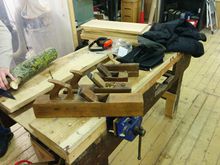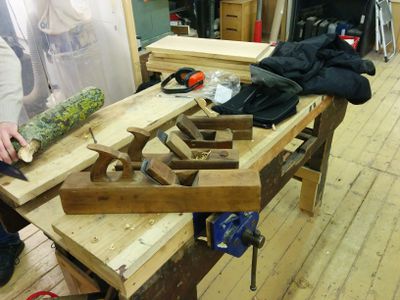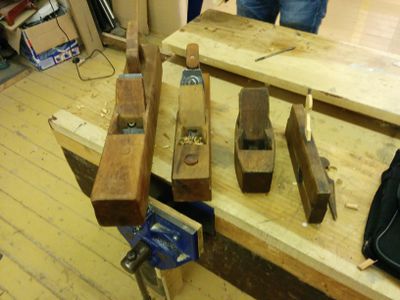Hand Planes
| Hand Planes | |
|---|---|
 | |
| Manufacturer | Various |
| Model | Various |
| Location | Workshop |
| Team | Woodworking |
| Induction Required | No |
| Tools: all pages • list • Power Tools • Broken tools {{}} | |
The space has a variety of Hand Planes.
For creating smooth surfaces on wood or making a thick piece of wood thinner these should be your first point of call, as generally a plane set to take a very fine shaving will leave a surface finish much smoother than sanding in a fraction of the time.
Wooden Planes
There are a variety of wooden planes available, each suited to a different task.


Using Wooden Planes
Wooden planes are set and adjusted using gentle, judicious taps with a small Warrington-Pattern hammer or soft faced mallet to the wedge, iron and (top of the) body. It will take practice to understand how much force is required to have the desired effect, but as excessive force may jam the wedge, dent the surface, or cause the body to split, it is best to err on the side of caution initially.
Initially the iron and cap-iron are inserted, positioned by eye looking down the sole of the plane, and held in approximate position (ideally very slightly short of where you'd like it to end up) whilst the wedge is inserted just firmly enough to hold them in place.
The wedge is then gently tapped into place to secure the iron, at this point the iron will often move sightly further out due to friction with the wedge as it's driven in.
The plane can then be adjusted by gently tapping the plane forwards of the iron to back it off slightly, or behind the iron to advance it, fine adjustments should not affect the wedge, but a large adjustment may loosen (backinf off) or tighten (advancing) the wedge substantially and it is desirable to release it and move the iron manually to close to the desired position instead.
The iron and wedge can be unset or removed by holding the plane vertically by the toe (front) in the non-dominant hand, whilst gripping the wedge and iron with the dominant hand and striking the heel (back) of the plane firmly against the bench; Normally a couple of strikes will be sufficient to release the iron, where this is not the case, a firm but measured tap to each side of the wedge, followed by gentle wiggling of the wedge to loosen it will do the trick.
If that's a bit too much text to wrap your head round, This video from Phil Edwards of Philly Planes (the UK's only remaining manufacturer of wooden planes), will likely explain rather more succinctly.
Types
Jack Plane
The first plane used in preparing a board, used along the length or diagonally to take coarse shavings to level the surface, remove imperfections and decrease the thickness of a board.
Some jack planes have a very slight camber (i.e. curvature) to the cutting edge of the iron to help it take the thickest shaving possible, this is not a defect and re-grinding the blade square would not be an improvement when others are available with a square iron.
Try Plane
Used after the Jack Plane to remove any scalloping left by the camber mentioned above, it's longer and wider to give it the best registration to the surface being planed, and uses a wider, square ground iron resulting in the flattest possible surface.
It is named after the process of trying an edge, that is planing it to 90° with the faces next to it. The process is so named because with each couple of passes it's essential to try (check) the squareness of the edge to the face using a try square (see a pattern anyone?)
The final use for the try plane is to joint a pair of boards to be edge glued, by clamping the two faces that will face up together, and then planing both of the edges being glued at the same time, you create a situation where the planing doesn't necessarily need to be at 90° to the faces. Glue can be applied to the jointed edges and the two pieces brought apart like opening a book before being clamped together, and any error in angle will self correct.
Coffin Smoother
The Coffin Smoother takes it's name from the shape of it's body, not it's purpose. The shape itself is designed to allow the body to be gripped directly in an ergonomic fashion, with the dominant hand gripping the tapered heel of the plane, and the non-dominant hand applying pressure over the toe of the plane.
As a smoothing plane, it may have a square ground iron with radiused corners, or an almost undetectable camber to the iron, in both cases this is to prevent the edge of the iron marring the near finished surface of your wood.
Smoothing planes have a very fine mouth, to limit the shaving thickness possible,and help prevent tear-out in wood where the grain is difficult.
Generally used for localised planing around areas of grain which run counter to the main grain, as found around knots, and in many figured hardwoods. Often the desire is to take a very fine shaving not to make the surface perfectly flat, but to remove any slight surface roughness to create the appearance of flatness, even if a very slight dip is introduced.
Also useful for chamfering the edges of a workpiece where leaving a sharp arris would be undesirable either ergonomically or due to the likelyhood of unsightly damage to the fine edge.
Rabbet Plane
Pronounced Rabbit (like the adorable and/or tasty creature with the fluffy tail), used to make a rebate (also known as a Rabbet) in workpieces.
The iron fits all the way to both sides of the plane's sole, allowing it to cut a groove and then run in that groove deepening it further, Whilst it would be impossible to describe all possible uses, the following are common.
- Cutting a pair of rabbets which will overlap to join two boards with additional mechanical strength over edge-gluing.
- Removing the waste from the centre of the female portion of a sliding dovetail joint.
- Removing the waste from a through dado (housing) joint when making case-work with shelves or internal divisions.
- Defining and tapering the edges of panels in small frame and panel work.
A variant of the rabbet plane has a skewed iron, which reduces the effective angle of the iron to the wood, enabling smoother cross-grain and end-grain cuts to be taken.